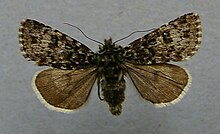Alpenmatten dwarf willow owl
| Alpenmatten dwarf willow owl | ||||||||||||
|---|---|---|---|---|---|---|---|---|---|---|---|---|

Alpine matted willow owl ( Hadula melanopa ) |
||||||||||||
| Systematics | ||||||||||||
|
||||||||||||
| Scientific name | ||||||||||||
| Hadula melanopa | ||||||||||||
| ( Thunberg , 1791) |
The hadula melanopa ( Hadula melanopa ) is a butterfly ( moth ) from the family of cutworms (Noctuidae). The species was previously assigned to the genus Anarta because of its external similarity , but is now counted to the genus Hadula due to its greater anatomical similarity .
features
The northern moths of the nominate form melanopa reach a wingspan of 20 to 26 millimeters, the front wings of which have a brown-gray or pale gray basic color. The pattern is irregular with small, teardrop-shaped spots. Cross and wavy lines stand out, as do ring and kidney flaws. The hind wings are whitish with a clear central spot and show a broad, brown fringe with white fringes. At the ssp. brunnea , the hind wings are also whitish in color and lighter and orange-brown elements can often be seen on the forewings. The slightly larger ssp. rupestralis reaches a wingspan of 25 to 29 millimeters and differs from the nominate form by the strongly darkened, mostly almost monochrome gray-brown hind wings.
The caterpillars are red-brown in color. They have a striking pattern of white and dark brown spots on the sides. The back line is thin, light ocher yellow and partially interrupted.
Geographical distribution and habitat
In northern Scandinavia the species is in the nominate form melanopa , in the high altitudes of the Alps , in the Balkan mountains and in the Apennines in the ssp. rupestralis and in some mountainous areas of the British Isles in the ssp. brunnea represented. But it is absent in the Carpathian Mountains and the Pyrenees . Preferred habitat are swamps above the tree line and rocky grass slopes in the high mountains up to the snow line.
Way of life
The moths are diurnal and like to visit the flowers of stems Losem campion ( Silene acaulis ) or saxifrage ( Saxifraga ). They fly in a generation from June to August. The caterpillars feed polyphagously on crowberries ( Empetrum ), blueberries ( Vaccinium ), silver arum ( Dryas octopetala ) or low-growing willow species ( Salix ). and pupate in a firm web in which the pupa usually lays for two years.
Hazard and protection
The species occurs in Germany only in the Bavarian Alps and is listed in category 3 (endangered) on the red list of endangered species . In very tightly limited places it can appear numerous.
swell
Individual evidence
- ↑ a b c d H. Hacker, Lázló Ronkay, Márton Hreblay: Hadeninae I.- Noctuidae Europaeae, Volume 4. , Sorø 2002, ISBN 87-89430-07-7 .
- ^ A b Walter Forster , Theodor A. Wohlfahrt : The butterflies of Central Europe. Volume 4: Owls. (Noctuidae). Franckh'sche Verlagshandlung, Stuttgart 1971, ISBN 3-440-03752-5 .
- ↑ Federal Agency for Nature Conservation (Ed.): Red List of Endangered Animals in Germany. Landwirtschaftsverlag, Münster 1998, ISBN 3-89624-110-9 .
literature
- H. Hacker, Lázló Ronkay, Márton Hreblay: Hadeninae I.- Noctuidae Europaeae, Volume 4. , Sorø 2002, ISBN 87-89430-07-7
Web links
- www.lepiforum.de - Taxonomy and photos
- www.schmetterlinge-deutschlands.de - endangerment
- Anarta melanopa in Fauna Europaea
